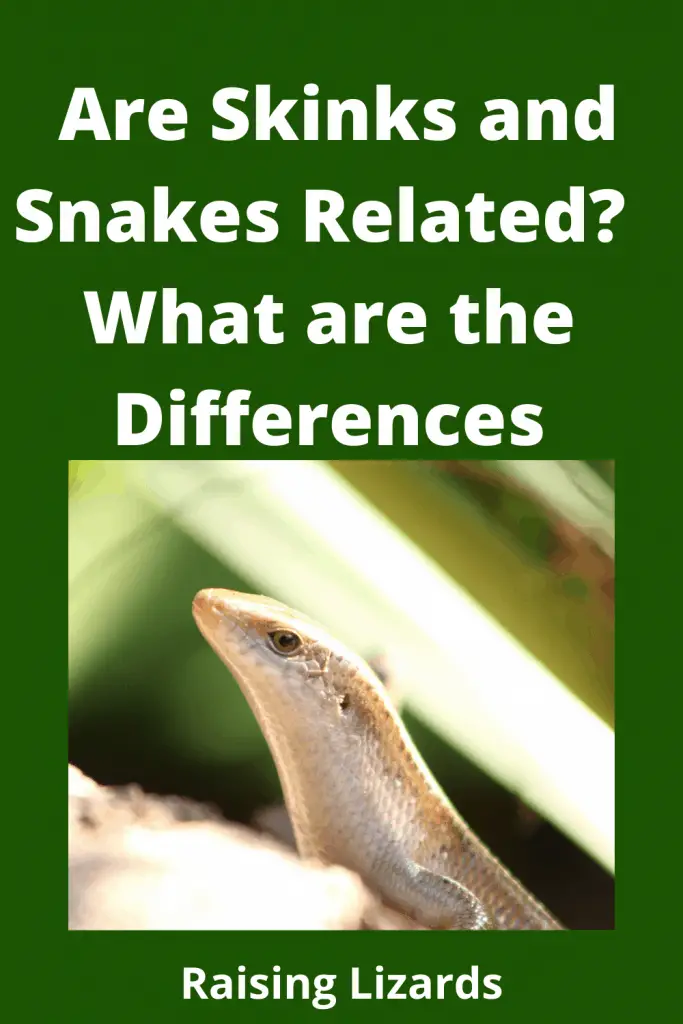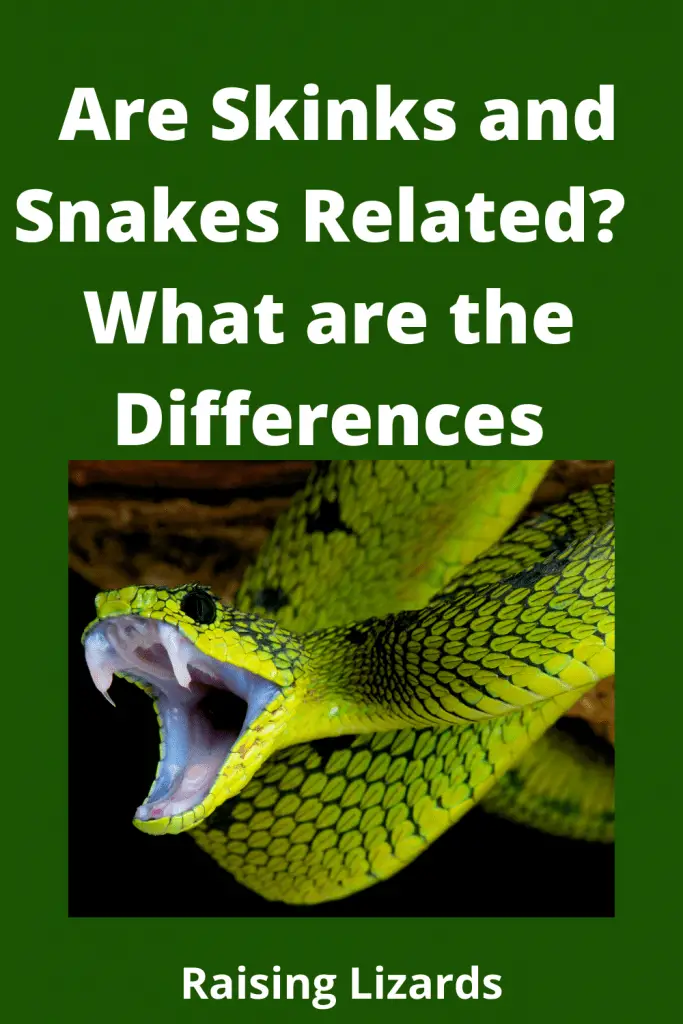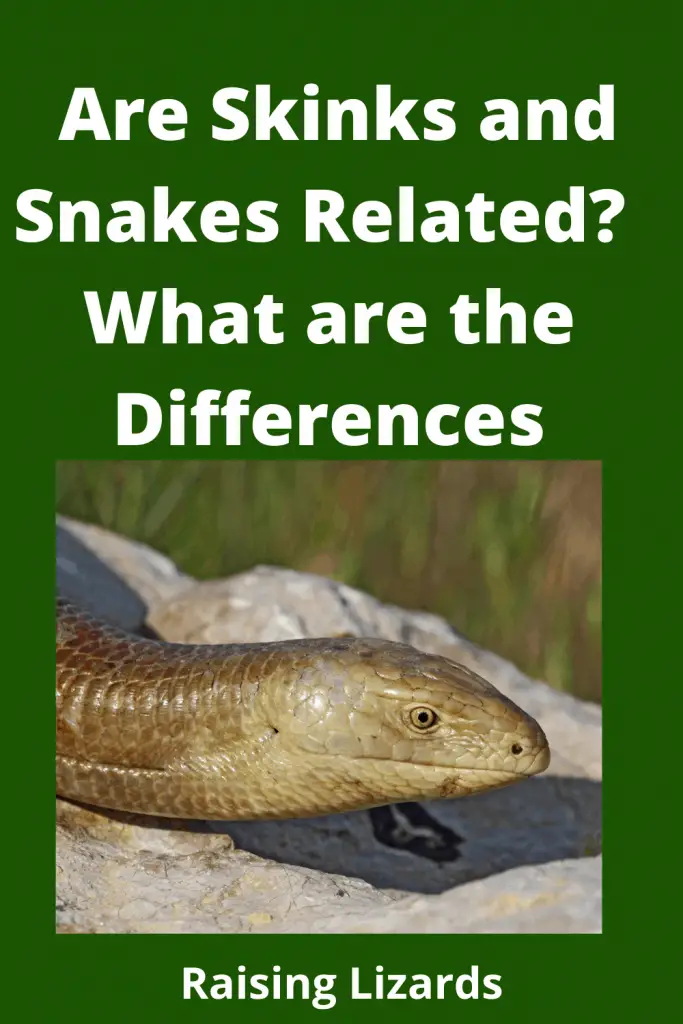Snakes are elongated, limbless, carnivorous reptiles, also called the serpent, any of more than 3,400 species of reptiles distinguished by their limbless condition and greatly elongated body tail.
While Skinks are lizards from the family Scincidae, a family present in the infraorder Scincomorpha, with more than 1,550 described species, the family Scincidae is one of the most diverse lizards’ families. Skinks seem to be a cross between a lizard and a snake. They have long bodies with short limbs. Some skinks do not have limbs at all! They also have long tails. There are well over a thousand different skink types, making them the 2nd most diverse lizards after iguanas.
The answer to this is only yes in one condition, i.e., Evolution. They are related but only in terms of Evolution. That’s why they are classified with lizards in the order Squamata. Other than that, Skinks and Snakes are not related very much. Both have major similarities and differences in their morphological structure, behavior habitat, etc. discussed below in this article.
Morphological Differences of Snakes from Skinks:
Snakes Have a Forked Tongue while Skinks Do Not
Snakes have strongly attached forked tongues, as do many lizards, such as Monitor lizards (such as the Komodo dragon), Gila monsters, and South American Tegus. But legless lizards(Skinks) lack the ability of forked tongue. There is not a single known Skink until now with a forked tongue.
When it comes to tracing food, this forked tongue plays a vital role and is incredibly useful.
Here’s how it work: Wandering animals leave microscopic taste particles in the air behind them. Snakes and some lizards collect by flicking on their forked tongues. After pulling the tongue back into the mouth, the chemicals are transported to the sensory organs called vomeronasal organs.

They help reptiles know what kind of creatures have created taste particles in question. However, Skinks are a diverse group of lizards, but not a single Skink is known as such a forked tongue’s characteristics as snakes do.
Snakes Do Not Have Eyelids, but Skinks do:
In this case, snakes cannot blink their eyes. Unlike us, reptiles do not have eyelids. Evolution has given them a different way of protecting invaluable pupils. In all the reptile species, a thin and transparent layer covers each eye for protection. They are known as “spectacles” or ” brilles.” Like most scales, they also change regularly when the snake sheds its skin.
Numerous lizards – most of them geckos – also have brilles instead of eyelids. However, many Skinks have eyelids. For example, consider the so-called “glass skinks.” These bright animals can be found in Morocco, North America, and some parts of Asia. Like snakes, glass lizards are legless: their forelimbs are completely gone, while their hindlimbs are modified into useless knobs buried under the skin. Yet, unlike snakes, glass skinks have moving eyelids.
Snakes Do Not Have External Ears Holes
It is often said that snakes are deaf. Over the last few decades, research has completely disproved this idea, and we now know that snakes can easily detect certain sounds that move through the air. So, where did the whole myth of not being able to hear snakes come from? This misinterpretation may have something to do with the fact that snakes do not have external ears.
Most land vertebrates have both the external ear and the inner ear. Snakes, on the other hand, lack the external ear or holes. Their inner ears are directly connected to the jawbone, which usually rests against the ground. Whenever another animal moves, its footsteps inevitably produce vibrations. They travel on the ground and, in response, cause the snake’s jaw to vibrate. The inner ear then responds to the brain, which interprets the data and identifies the sound source. Snakes can also detect the low-frequency noise that travels through the air in the same way.
Take a nearer look at the snake, and you will see no ear holes on either side of its head. In contrast, most lizards have a pair of external ear holes. And again, this is not true in all cases; some skinks also do not have ear holes. Australian Aprasia lizards have been adapted to a lifestyle that does not require external ear openings.
Snakes Jaws are More Flexible than Skinks:
Contrary to popular belief, snakes do not unhinge or separate their jaws when feeding. They don’t need to. An average snake can swallow prey that is many times larger than its head. This feat is made possible by the amazingly flexible jaw set.
Similar to humans, the lower jaw of a snake consists of two bones called mandibles. Our mandibles meet to make a chin. Snakes mandibles are not fused like humans. Instead, the two lower jaws can move freely and independently and are significantly separated.

In contrast, the jaws of most Skinks are much less moveable. As a result, they eat smaller prey – but there is an exception to this rule. Burton’s Snake Lizard (Lialis Burtonis) is an unusual predator that specializes in eating other lizards.
When Threatened, Many Skinks can Discard and Regrow Their Tail
If a snake, crocodile, or tortoise loses its tail, the animal will not regrow its tailback. But, in the world of reptiles, that ability is unique to lizards/Skinks. Many – but not all – lizard species can famously lose a part of their tail and then regenerate it (although it is not as good as the original).
This is no parlor trick: in the wild, it’s a potentially life-saving tactic. If a predator catches a Skinks by its tail, it can break its entire joint. After that, this lost appendage can flail and spasm and become and distract the attacker long enough that skinks/Lizards got enough time to escape.
Interesting Information:
There is a correlation between Skink’s habitat and the length of their tails. Skinks that covered themselves in dirt or spent most of their time submerged in the sand have a relatively short tail. In contrast, those who live on the surface have a much longer tail. The long tails of skinks with ground habits can cause a problem when they drag too much into the sand while digging. However, on top of the soil, a long tail reduces some predators’ odds of snatching a more important part of the body.
How do you Differentiate a Snake from a Skink?
Does it have eyelids?
- If it has eyelids, then it’s a skink.
- If it does not possess eyelids, then it’s a snake (probably). Snakes have a prominent “spectacle” above their eyes.
Does it have a fleshy tongue?
- If yes, then it’s a lizard. (except monitor lizards)
- If no, then it’s a snake. Snakes have long thin forked tongues.
Does it have a long tail?
This may sound like an unintelligent question, aren’t all snakes have tails? The tail is a small spinal cord area where the snake’s pelvis is present or would be. This can also be determined by the animal’s urogenital opening, known as “Vent.” It is a scale-covered s; it through which reptiles expel, defecate and regenerate.

- Yes – it’s a lizard. Vents of lizards are far from their tails. But to complicate things, many skinks can drop their tails as a trick to evade the hunter. So, the presence of a regulating, stumpy tail is also proof that it is not a snake.
- No – it’s a snake. Snake vents are far from their heads (and snakes cannot let go of their tails).
Do the scales on its back and belly look alike?
- If yes, then it’s a lizard.
- If no, then it’s a snake. Snakes move by undulating their elongated rectangular scales (or sometimes pairs of scales) along their bellies, every scale gripping and pushing against irregularities on the ground. Snakes can’t move over Teflon.
Similarities Between Skinks and Snakes:
Male snakes and male lizards have compatible copulatory components. Both possess paired copulatory organs, known as hemipenes. Skinks and snakes carry the hemipenes internally, inverted inside the bases of their tails.
- If skinks are limbless, both snakes and skinks look alike. We must differentiate them from the differences mentioned above.
- Both of them are carnivores in nature. Skinks usually ate small insects and eggs while snakes, due to larger, have multiple options.
- Both of them are found in the desert, jungle, plains, and mountains. That’s is they can found almost everywhere in the world.
- Both have skin-deep similarities, e.g., in terms of body scales.
The Legless Lizard (Skinks) Examples
- California legless lizard(California Skink)
- Island glass lizard (Island glass Skink)
- Eastern glass lizard (Eastern glass Skink)
- Mimic glass lizard (Mimic glass Skink)
- Slender glass lizard (Slender glass Skink)
Key Features:
We can broadly say that snakes represent a lizard that, throughout Evolution, has undergone structural reduction, simplification, and loss as well as specialization.
The term ‘Skinks refers to several groups of lizards that, through Evolution, have either lost their limbs or reduced them up to such an extent that they serve no locomotive purpose. These skinks are snake-like in appearance.
Skinks Prices
| Species of Skinks | Lifespan | Largest Length | Price | |
|---|---|---|---|---|
| Blue Tongue Skinks | 20 Years | 24" | $199- $499 | |
| Schneider's Skinks | 20 Years | 18" | $ 60 | |
| Blue Tailed Skinks | 8 - 10 Years | 5" - 8.5" | $ 14.99 | |
| Red-Eyed Crocodile Skinks | 12 Years | 8" - 10" | $ 199 | |
| Monkey Tailed Skinks | 20 Years | 32" | $ 799 | |
Fire SkiRed-Eyed Crocodile Skinks | 12 Years | 8" - 10" | $ 188 - $ 279 | |
Lifespan
Size
Price
Lizard Habitats and Facts
| Lizard Type | Foods | Adult Size | Vivarium Type | Eggs | Temperament | Country Origin | Price |
|---|---|---|---|---|---|---|---|
| Ameiva | Insects | 20 " | Tropical Woodland | 2-8 | Aggressive | Central, South America | $ 49.99 |
| Alligator Lizard | Insects | 20" | Semi- Aquatic | 6-12 | Aggressive | North America | $ 18 |
| Asian Water Dragons | Carnivorous | 40" | Tropical Woodlands | 8-16 | Aggressive | Asia | $ 18 - $ 80 |
| Panther Chameleon | Insects | 12" | Tropical Woodlands | 30-50 | Aggressive | Madagascar | $ 150 - $ 600 |
| Jacksons Chameleon | Insects | 14" | Temperate Woodlands | Up to 30 Live Young | Aggressive | East Africa | $ 75 - $175 |
| Giant Day Gecko | Insects | 10" | Tropical Woodlands | 2 | Aggressive | Madagascar | $ 79.99 |
| Leopard Gecko | Insects | 10" | Desert | 2 | Aggressive | Asia, India | $ 30 - $ 45 |
| Tokay Gecko | Insects | 14" | Tropical Woodland | 2 | Aggressive | Southeast Asia, New Guinea | $ 39.99 |
| Blu Tongue Skink | Vegetarian | 20" | Savannah | 6-25 | Aggressive | New Guinea, Australia | $ 150 - $ 649 |
| Common Walled Lizard | Insects | 8" | Savannah | 3-8 | Aggressive | Central Europe | $ 460 - $ 600 |
| Green Lizard | Insects | 16" | Savannah | 6-20 | Aggressive | Europe, Southern Asia | ? |
| Green Iguana | Vegetarian | 60" | Tropical Woodland | 20-40 | Aggressive | Central, South America | $ 39 - $ 55 |
| Desert Iguana | Vegetarian | 15" | Desert | 3-10 | Aggressive | USA, Mexico | $ 34.99 |
| Six Lined Racerunner | Insects | 11" | Savannah | 4-6 | Aggressive | USA | $ 29.99 |
| Chinese Crocodile Lizard | Carnivorous | 12" | Semi- Aquatic | 2-12 Live Young | Aggressive | China | $ 1200 |
| Collared Lizard | Insects | 14" | Desert | 4-24 Eggs | Aggressive | USA, Mexico | $ 53.99 |
| Western Fence Lizard | Insects | 9" | Savannah | 6-13 | Aggressive | USA | $ 19.99 |
| Chuckwalla | Vegetarian | 18" | Desert | 6-13 eggs | Aggressive | Mexico | $ 88.99 |
| Green Anole | Insects | 9" | Tropical Woodland | 2 | Aggressive | Southern USA | $ 10.00 |
| Brown Anole | Insects | 8" | Tropical Woodland | 2 Eggs | Aggressive | Caribbean, Central America | $ 3.99 - $ 7.99 |
| Knight Anole | Insects | 22" | Tropical Woodland | 1-2 | Aggressive | Cuba | $ 39.99 |
| Nile Monitor | Carnivorous | 79" | Savannah | 10-60 | Aggressive | Egypt | $ 69.99 |
| Bosc's Monitor | Carnivorous | 69" | Savannah | 10-50 | Aggressive | Central Africa | $ 100 - $ 150 |
| Bearded Dragon | Insects | 20" | Desert | 15-30 | Social | Australia | $ 60 - $ 400 |
| Agama | Insects | 16" | Savannah | 10-20 | Aggressive | North Africa | $ 24.99 |
| Five Lined Skink | Insects | 9" | Temperate Woodland | 15 | Aggressive | Africa | $ 10 |
| Red Tailed Rock Lizard | Insects | 8" | Savannah | 2-4 | Aggressive | South Africa | ? |
Food
Size
Vivarium Type
Country Origin
Price
Eggs
Temperament
Approx Cost
| Type of Lizard | UBV / UVA / Lighting | Temperature Range Basking | Gradient (warm-cool) | Night Temp | Humidity Range |
|---|---|---|---|---|---|
| Bearded Dragons | Desert 50 | 100-110 F | 90-80 F | 70-75 F | 25-40 % |
| Uromastyx | Desert 50 | 100-120 F | 85-80 F | 70-75 F | 30 % |
| Green Iguana | Desert 25 | 90-100 F | 90-70 F | 70-75 F | 60-80 % + Spray Mist |
| Chinese Water Dragon | Desert 25 | 90-100 F | 90-70 F | 70-75 F | 60-80 % + Spray Mist |
| Nile Monitors | Desert 50 | 90-95 F | 90-80 F | 75-80 F | 40-60 % |
| Savannah Monitors | Desert 50 | 100-110 F | 92 - 80 F | 72-80 F | 40-50 % |
| Emerald Swift | Desert 50 | 90-95 F | 90-75 F | 68-75 F | 70-90 % |
| Tegus | Desert 50 | 90-100 F | 90-80 F | 70-75 F | 60-80 % |
| Green & Bahamma Anoles | Desert 25 | 90-100 F | 90-75 F | 68-75 F | 70-80 % + Spray Mist |
| Blue Tongue Skinks | Desert 50 | 90-95 F | 85-75 F | 70-75 F | 30-50 % |
| Schneider Skinks | Desert 50 | 95-105 F | 90-80 F | 68-70 F | 30-50 % |


